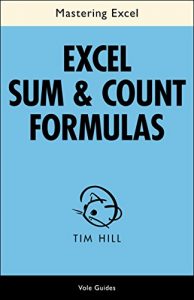Updated for Excel 2016. Summing and counting values are the most common spreadsheet operations, and Excel's capabilities go far beyond routine SUM and COUNT formulas. Author Tim Hill shows you how to use worksheet functions, array formulas, AutoSum, and other Excel features to summarize an entire range of values, or only values that meet specific conditions. If you're using an older version of Excel that doesn't support the latest worksheet functions, you'll find equivalent formulas that work in Excel 2003 or earlier. You can download the sample workbook to follow along with the author's examples.
- Covers all versions of Excel.
- Display sums and counts without using formulas.
- Master the basics of COUNT, COUNTA, COUNTBLANK, and other counting functions.
- Create conditional counts with COUNTIF and COUNTIFS.
- Calculate the mode for numeric or text values.
- Count unique values in a range.
- Count occurrences of specific text strings.
- Create frequency distributions and histograms.
- Master the basics of the SUM function.
- Use AutoSum to sum values quickly.
- Calculate running totals.
- Sum only the highest or lowest values in a range.
- Eliminate rounding errors in financial calculations.
- Sum every Nth value in a range.
- Create conditional sums with SUMIF and SUMIFS.
- Plenty of tips, tricks, and timesavers.
- Fully cross-referenced, linked, and searchable.
Contents
1. Getting Started with Sums & Counts
2. Counting Basics
3. Counting Tricks
4. Frequency Distributions
5. Summing Basics
6. Summing Tricks
About the Author
Tim Hill is a data miner based in Las Vegas, Nevada. When he's not crunching numbers, Tim plays poker, hikes canyons, and avoids malls.
- Covers all versions of Excel.
- Display sums and counts without using formulas.
- Master the basics of COUNT, COUNTA, COUNTBLANK, and other counting functions.
- Create conditional counts with COUNTIF and COUNTIFS.
- Calculate the mode for numeric or text values.
- Count unique values in a range.
- Count occurrences of specific text strings.
- Create frequency distributions and histograms.
- Master the basics of the SUM function.
- Use AutoSum to sum values quickly.
- Calculate running totals.
- Sum only the highest or lowest values in a range.
- Eliminate rounding errors in financial calculations.
- Sum every Nth value in a range.
- Create conditional sums with SUMIF and SUMIFS.
- Plenty of tips, tricks, and timesavers.
- Fully cross-referenced, linked, and searchable.
Contents
1. Getting Started with Sums & Counts
2. Counting Basics
3. Counting Tricks
4. Frequency Distributions
5. Summing Basics
6. Summing Tricks
About the Author
Tim Hill is a data miner based in Las Vegas, Nevada. When he's not crunching numbers, Tim plays poker, hikes canyons, and avoids malls.






